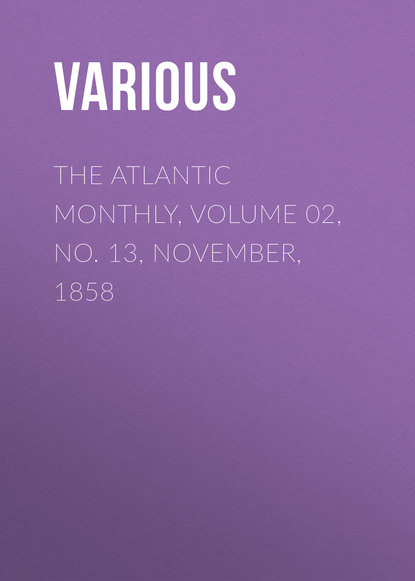 Полная версия
Полная версияПолная версия:
The Atlantic Monthly, Volume 02, No. 13, November, 1858
We have not space in this number to give Mr. White's Shakspeare the welcome it deserves. We have examined it with some care, and can speak with decision of its very great merits. It is characterized by taste, industry, and conscientiousness. We believe it to be, in all essential respects, the best—it is certainly the most beautiful—edition of Shakspeare. This is also from the press of Houghton & Company.
* * * * *We notice with pleasure among recent literary announcements those of a History of France, by Parke Godwin, Esq., and of New England, by Dr. J.G. Palfrey. Both are desiderata, and the reputation of the authors is such as to warrant the highest anticipations.
1
Handbook of Railroad Construction, for the Use of American Engineers. By GEORGE L. VOSE, Civil Engineer. Boston and Cambridge: James Munroe & Company. 1857.
Baltimore and Ohio Railroad Reports, from 1830 to 1850. BENJAMIN H. LATROBE, Chief Engineer.
Railways and their Management, being a Pamphlet written by JAMES M. WHITON, ESQ., late of the Boston, Concord, and Montreal Railroad. 1856.
Report of the President, Treasurer, and General Superintendent of the New York and Erie Railroad Company to the Stockholders. March, 1856.
Final Report of JOHN A. ROEBLING, Civil Engineer on the Niagara Railway Suspension-Bridge, May, 1855.
2
Lest these statements should sound extravagant, the reader will please reckon up the amounts for himself. A bank twenty-five feet wide on top, eight hundred feet long, and two hundred and thirty feet high, would contain two million cubic yards of earth; which, at twenty-five cents per yard, would cost half a million of dollars, exclusive of a culvert to pass the river, of sixty, eighty, or one hundred feet span and seven hundred feet long. Twenty trains per day, of thirty cars each, one car holding two yards, would be twelve hundred yards per day; two million, divided by twelve hundred, gives 1,666 days.
3
The most careless observer has doubtless noticed that the front part of a locomotive rests upon the centre of a track, having four small wheels; the back and middle part, he will also remember, is borne upon large spoke wheels,—which are connected with the machinery; upon the size of these last depend the power and speed of the engine. The larger the wheels, the less the power, and the higher the velocity which may be got; again, the wheel remaining of the same size, by enlarging the dimensions of the cylinders the power is increased; and the wheels and cylinders remaining the same, by enlarging the boiler we can make stronger steam and thus increase the power. There may be seen upon the road from Boston to Springfield engines with wheels nearly seven feet in diameter, used for drawing light express-trains; while upon the roads ascending the Alleghanies may be seen wheels of only three and a half feet diameter, which are employed in drawing trains up the steep grades. Increase of steepness of grades acts upon the locomotive in the same manner as increase of actual load; as upon a level the natural tendency of the engine is to stand still, while on an incline the tendency is to roll backwards down-hill.
4
: See Colin Clout's come home again.
5
Vide Scott's Life.
6
Upton's Faëry Queen, Vol. I. xiv.
7
See Wood's Athenæ Oxonienses.
8
See Hunter's New illustrations of Shakspeare, Vol. II. p. 280.
9
Book II. Canto vi. etc.—See Black's Life of Tasso, Vol. II. p. 150.
10
Upton, Vol. I. p. 14.—Faëry Queen, Book VI. Canto vi. st. 10, 17.
11
Vide that to Queen Anne.
12
Cornwallis's Essays, p. 99.
13
Camden's Remains, folio, 1614, p.164.
14
Iliad, Z. 265.
15
Faëry Queen, Book VI. Canto x.
16
Sonnet lxix.
17
: Sonnets lxxiii, lxxv, and lxxxii.
18
Sonnet i.
19
Sonnet viii.
20
Sonnet xvii.
21
Sonnet lxi.
22
Sonnet lxxix.
23
Sonnet lxxxiii.
24
Stanza 9.
25
Stanza 13.
26
Verstigan's Restitution of Decayed Intelligence, p. 226.
27
The Life of Thomas Jefferson. By HENRY S. RANDALL, LL.
D. In three volumes. New York: Derby & Jackson. 1858.
28
The Life of Thomas Jefferson. By HENRY S. RANDALL, LL.
D. In three volumes. New York: Derby & Jackson. 1858.
29
Mandatum Novum:—hence the name of "Maundy Thursday."
30
It is worth mentioning, that among the deserters was one valorous writing-master, who had previously prepared a breastplate of two quires of his-own foolscap, inscribing thereon, in his best penmanship,—"This is the body of J.M.; pray, give it Christian burial."
31
London Cotton-Plant, 21st August, 1858.
32
Ibid. 18th September. 1858.
33
It is a coincidence that the recapture of runaways did more than anything else to abolish villanage in England.
34
See COBB on Slavery, (Philadelphia: T. & J.W. Johnson & Co., 1858,) where these admissions are made. (Introd. pp. 218-220.) This work, written by Mr. Thomas R. R. Cobb, of Georgia, is, considering the natural prepossessions of the author, singularly calm and candid. We commend it to our readers, as bringing together a great deal of information, and still more as showing the remarkable change which has come over the Southern mind, even among moderate men, on the subject of Slavery. We shall take a future occasion to notice it more fully.



